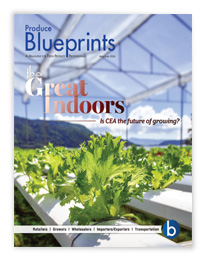We talked with Lance Jungmeyer, President of The Fresh Produce Association of the Americas (FPAA) BB #:144354, Nogales, AZ, in late 2020 for the Produce Blueprints Nogales Supplement to the January/February 2021 issue.
How would you characterize 2020 in terms of successes and losses for the Nogales produce industry?
Last year, 2020, was a very difficult year for many reasons. The industry had to start preparing for increased tomato inspections (from the updated Tomato Suspension Agreement) and deal with the Covid pandemic and an even more protectionist environment. But, for many companies, it still was a successful year.
Has the revised Tomato Suspension Agreement affected border crossings?
The inspections have slowed down the import of tomatoes and other items. Tomato inspections increased anywhere from 50 to 100 percent. Those that need to have their grapes, citrus, etc. inspected now have to wait in line with tomatoes as required under the agreement. A whole bunch of companies have had their businesses disrupted.
Our contention all along has been that the [tomato] inspections serve no purpose other than to slow down imports, and we still believe this. It acts as a barrier to trade. Before the Tomato Suspension Agreement, there was a 99-percent pass rate, and we are still at a 99-percent pass rate.
How did the Covid-19 pandemic affect imports through Nogales?
There was a demand arc; it highlighted the difference between the retail market and foodservice.
In March, when there were lockdowns, produce imports went up because the produce was geared toward the retail market. A strong burst of demand was fulfilled. In April there was an oversupply, but it quickly equalized. The season ended quite successfully depending on the product available.
What has the FPAA done to help its members deal with the pandemic?
We take the best information we have and make the best choices for our members to ensure companies and their employees have all the support they need.
There are challenges to running an operation efficiently when you’re dealing with illness in the community. Sales, marketing, and accounting have different operating challenges than the warehouse function.
Covid-19 hit the Southwest hard in May and coincided with the increased inspections. We asked the U.S. Department of Agriculture (USDA) for a temporary waiver to reduce the inspections; it was denied. The inspections need to be done with the least amount of movement of people and share of indoor space.
We worked with state and county officials, Western Grower Insurance Services, and health providers to offer quick and reliable testing, develop best practices for preventing the spread of the virus in produce warehouses, and offer webinars on how to set up businesses for safety.
As an association, we shifted to meetings online.
What measures did members put in place for their businesses?
It depends on the size of the business. Some have only two or three employees; others have 100 or more. Temperature checks are common, as well as self-questionnaires for workers to assess themselves. If associates have symptoms, they need to talk to HR and work with the county on contact tracing.
Aside from the pandemic, what do your members think about the U.S.-Mexico-Canada Agreement (USMCA)?
We are extremely pleased the agreement was signed. The prospect of going back to tariffs was not a positive for the industry. But the action the United States has taken on the seasonality issue is not in the spirit of USMCA. It’s a step backward.
With respect to the seasonality issue, with growers in the Southeast claiming unfair trade practices, the U.S. Trade Representative (USTR) issued a request to the International Trade Commission to initiate a Section 201 global safeguard investigation on blueberry imports, which was followed by actions on strawberries and green peppers as well. What is the FPAA’s position on these actions?
Growers in the Southeast had to discard some of their produce because of Covid. During this time period, they took the opportunity to get protection from imports.
A Section 201 investigation is unwarranted in regard to Mexico. Mexican subsidies have averaged just 2 percent since 1995. This is the first time the United States has used this Section on produce since it was enacted.
At the federal hearings in August, there was no proof or evidence presented to justify the USTR’s action. It was handed down for political reasons. We feel some concessions were offered to Southeast growers to support USMCA.
With respect to green bell peppers, demand has dropped considerably compared to other colored peppers (yellow, orange, and red), which must be left on the plant longer. It costs more and there is more possibility of damage unless they’re grown in a greenhouse.
In the Southeast, the bell peppers grown are primarily green. The principal mode of growing is outdoors, so yields of other colored bell peppers are low. In Mexico, growers have invested in greenhouses, special seed varieties, and controls to come up with a pepper that meets demand. The FPAA’s position is that the United States is putting up trade barriers because Southeast companies can’t grow other colored peppers. This limits choice to a product that some consumers are rejecting.
Farmers need to be successful and profitable. If this goes forward, other countries will retaliate. It would increase prices and reduce the ability to export.
Many members of FPAA are also exporters. This is a negative precedent for both imports and exports—the actions are benefitting a few states in the Southeast and hurting states in the West.
What’s the status of the State Road 189 overpass project, connecting the state highway from the port to Interstate 19?
It’s under construction—we broke ground last March. When completed, it’s going to speed up trucks going north by about 10 minutes per truck. Each day there are about 1,600 trucks crossing. That’s a substantial savings for suppliers. It will also increase safety. We’re happy about the investment the state has made.
The project is a public-private partnership in that a portion of the cost is covered from a special fee on fresh produce trucks of a certain weight coming into the port. Those funds are divvied up: the state gets 50 percent, the county gets 25 percent, and Nogales gets 25 percent. They have pledged the money to the project.
For a small community of 22,000 people, getting a $100 million-plus project by itself would not happen. It’s a driver for investment. The add-on component to this improvement is the construction of the new cold inspection facility at the port. It’s a great advance.
How is the new cold inspection facility expected to affect produce coming through Nogales?
We expect construction of the new cold inspection facility to begin during the first quarter of this year. The facility will enable more imports of sensitive items during the hot summer months without suffering any degradation of quality.
Nogales can go from a seasonal port to year-round for any product. The facility was made possible through partnerships with the state, county, Nogales U.S. Customs Brokers Association, Greater Nogales Port Authority, and FPAA.
How do you think 2021 will compare to 2020? Will the port and suppliers get back to business as usual, or are operations forever changed?
We sell produce, people need to eat; our members can’t visit their customers, everybody is adapting.
We’re also going to be in the first full year of USMCA. With the election behind us, we hope for a less confrontational dialogue with Mexico and Canada. When tariffs are put on Canadian steel and unjustified inspections are put on tomatoes, it doesn’t provide confidence in the relationship. We need to work toward a common goal.
There’s great opportunity in 2021 to forge ahead with relationships that have resulted in greater food safety, improved varietal selection, and lower prices. Compared to pre-NAFTA, the market is vastly improved for customers and retailers.
What are you most looking forward to in 2021?
I look forward to hearing from the industry on ways we can help businesses improve and be more competitive. As an association, that is what we do: we listen, we try to find solutions, and we bring people together.



